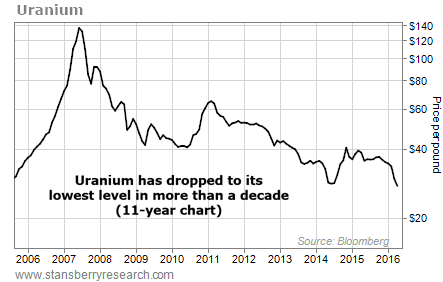“We had anticipated things would get better sooner.”
That’s what Tim Gitzel, the CEO of uranium major Cameco (CCJ), told shareholders at the company’s annual meeting last month.
In April, Cameco suspended operations at its Rabbit Lake uranium mine in northern Saskatchewan. Until then, Rabbit Lake was the longest-producing uranium operation in the province.
[ad#Google Adsense 336×280-IA]Cameco also delayed development of wells at its U.S. operations.
The decisions caused more than 500 employees to lose their jobs.
Gitzel’s words reflect the tough uranium market that’s still ongoing today.
A bear market has gripped uranium for the past decade.
Conditions began to improve slightly from mid-2010 to early 2011.
But in March 2011, a magnitude 9.0 earthquake and tsunami caused severe damage to the Fukushima Daiichi nuclear plant in Japan… and sent the industry reeling again.
The resulting decrease in demand coincided with competition from low-priced natural gas and coal. This combination has sent uranium prices plummeting to their lowest level since 2005…
As you can see in the chart below, the trend looks bleak for uranium…
 And even though uranium prices are down about 80% from their peak in mid-2007, improved plant efficiencies and the closure of older plants have slowed demand growth.
And even though uranium prices are down about 80% from their peak in mid-2007, improved plant efficiencies and the closure of older plants have slowed demand growth.
Uranium miners like Cameco have been hit hard in the past couple of years…
 Low prices devastated production. In the first quarter of 2016, U.S. production of uranium fell from 1.2 million pounds to 626,000 pounds, a decline of nearly 50%.
Low prices devastated production. In the first quarter of 2016, U.S. production of uranium fell from 1.2 million pounds to 626,000 pounds, a decline of nearly 50%.
That drop in production makes sense when you look at the decline in nuclear power plants in recent years. In 2012, there were 104 nuclear power plants operating in the U.S. Today, there are just 99. According to the Nuclear Energy Institute, we could see up to 20 of the existing plants close early.
It’s clear uranium miners need more plants to come online. Most of this new production will take place in other parts of the world, namely China, India, and Korea.
Like all commodities, uranium is a cyclical industry. We expect the market to improve eventually. Cameco’s decision to curtail production in the U.S. and Canada is a positive. The opening of new nuclear power plants will help, too.
Demand will improve once the plants sign long-term supply contracts. Until now – with prices falling at a steady clip – they’ve chosen not to lock in higher prices.
That’s why we’re avoiding these uranium miners for now. We still need to be patient with uranium stocks. We’ll keep an eye on the market and wait for a turn.
Good investing,
Matt Badiali
[ad#stansberry-ps]
Source: Growth Stock Wire
